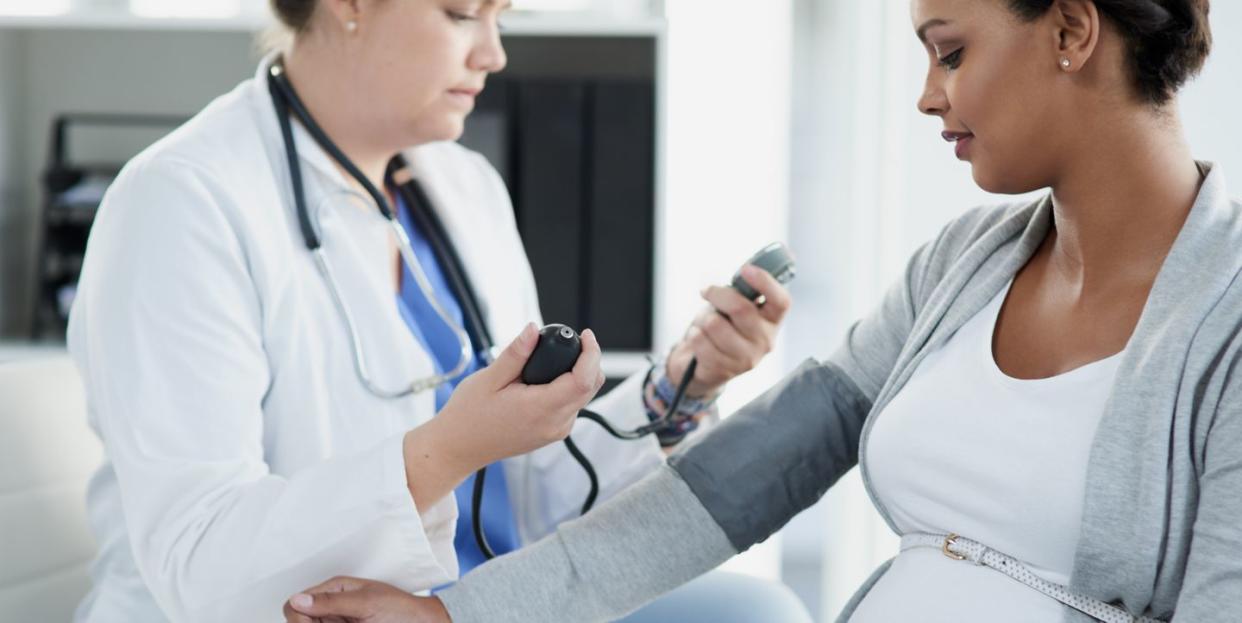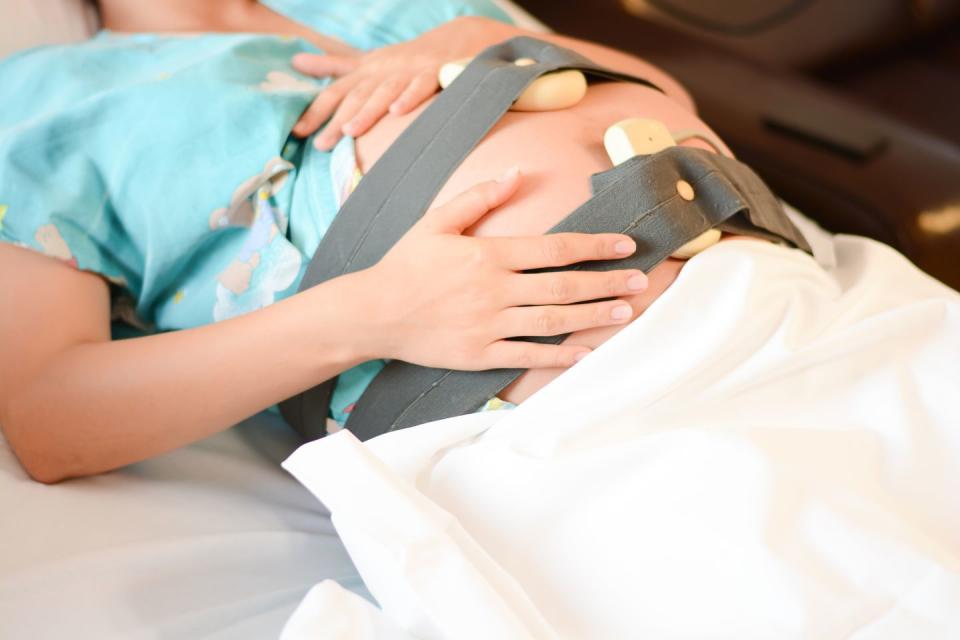The signs you are at risk of pre-eclampsia during pregnancy

Pre-eclampsia is a condition that can develop during pregnancy. While it’s usually mild, left untreated it can be life threatening for both mother and baby, so it's important that you attend routine antenatal checks and report any pre-eclampsia signs and symptoms to your midwife or doctor.
However, only one per cent of women develop severe pre-eclampsia and complications are rare, so provided you are monitored properly, you and your baby are likely to stay safe and healthy.
Dr Juliet McGrattan talks us through pre-eclampsia causes, symptoms, treatment and possible complications:
What is pre-eclampsia?
Pre-eclampsia is a condition that happens in around six in 100 pregnancies in the UK. Women develop high blood pressure and protein in the urine. It develops in the second half of pregnancy, usually from 24 weeks onwards. It is very rare before 20 weeks. It can also develop up to six weeks after the baby has been born.
While most cases of pre-eclampsia are mild, around one per cent of pregnant women develop severe pre-eclampsia which can be potentially life threatening for mother and baby. It’s important that the condition is identified, monitored and treated to avoid complications.
What causes pre-eclampsia?
It’s not clear exactly what causes pre-eclampsia but it does seem to be triggered by the placenta. The placenta is what delivers oxygen and nutrients from the mother’s blood to the growing baby. If the placenta doesn’t develop properly or becomes damaged, then the baby cannot get enough nutrients to grow properly. It’s thought that these abnormalities may develop in the first month or two of pregnancy when the placenta is beginning to grow.
Theories include that either the placenta isn’t receiving enough blood from the mother or that the immune system is reacting against the placenta. The abnormal placenta releases substances into the blood stream which cause the mother’s blood vessels to narrow and spasm and this increases her blood pressure. They also trigger the kidneys to become leaky, allowing protein, which would normally be kept in the blood stream, to escape in the urine.

Pre-eclampsia risk factors
Any woman can potentially develop pre-eclampsia during pregnancy, but there are certain factors that put you at more risk.
Particularly important risk factors include women with the following conditions:
High blood pressure before pregnancy.
Previous kidney disease.
Pre-eclampsia in a previous pregnancy – the earlier in the pregnancy it develops, the higher the risk of recurrence.
Auto-immune conditions such as lupus or antiphospholipid syndrome.
There are many other less crucial risk factors. The more of these that are present then the higher the risk. These include:
Being overweight – BMI 35 or more.
Being pregnant over 40 years of age.
First pregnancy.
More than ten years since the last pregnancy.
Having multiple babies eg twins or triplets.
Having a family history of pre-eclampsia.
Pre-eclampsia signs and symptoms
The most common pre-eclampsia signs are not ones that a pregnant woman will identify herself. These include:
High blood pressure
Protein in the urine on a dip stick test
This is why it is important to attend routine checks during pregnancy, even when you feel well. Some women will have a raised blood pressure in pregnancy without it being pre-eclampsia so it is important that urine is tested too.
There are some symptoms of pre-eclampsia that may develop slowly or may come on quite suddenly and rapidly. It is good to be informed so you know what to look out for.
Pre-eclampsia symptoms include:
Headache – a severe headache, usually in the front of the head which doesn’t go away with your usual painkillers.
Fluid retention – sudden increase in swelling of ankles, feet, hands or face.
Visual changes – blurred vision or flashing lights problems.
Heartburn – not easing with your usual indigestion remedies.
Nausea or vomiting
Upper abdominal pain
Feeling very unwell
It’s unusual for symptoms of pre-eclampsia to develop before 24 weeks. Most tend to develop from 32 weeks. It is very rare before 20 weeks.
Pre-eclampsia diagnosis
Your midwife or doctor will check your blood pressure and dip your urine at routine antenatal checks. They will be concerned about pre-eclampsia if the following occurs:
Your blood pressure reading is 140/90mmHG or more.
There is protein in your urine. They may repeat this several times on different samples or even ask you to collect urine over 24 hours.
Pre-eclampsia is assessed and monitored by specialists in hospital, so if your midwife or doctor has any concerns about the possibility of pre-eclampsia then you will be referred urgently.
There is a blood test called PlGF (placental growth factor) which helps doctors diagnose pre-eclampsia. Low levels of PlGF can indicate that pre-eclampsia is present.
Pre-eclampsia treatment
The only cure for pre-eclampsia is for your baby to be delivered. Medical treatment aims to keep you and your baby well and healthy for as long as possible until delivery is appropriate.
✔️ Hospital monitoring
You and your growing baby will be closely monitored in hospital with frequent blood pressure checks, ultrasounds and monitoring of the baby’s heart rate (cardiotocography – CTG).
✔️ Delivery
Delivery, by inducing vaginal birth or performing a Caesarean section, is usually recommended at 37 to 38 weeks, but if pre-eclampsia is severe it may be done earlier than this.
✔️ Blood pressure medications
Blood pressure medications will be given, the most commonly used is the beta-blocker called labetolol. Lowering blood pressure helps to reduce the risk of stroke in the mother.
✔️ Low dose aspirin and calcium
Low dose aspirin and calcium supplements may be also be recommended. If there is concern about pre-eclampsia progressing to the serious condition of eclampsia, then magnesium sulphate may be prescribed.
✔️ Steroids
If the baby is going to be delivered early then the mother will be given steroids to help the baby’s lungs mature.
Pre-eclampsia potential complications
Mild pre-eclampsia is more common than severe pre-eclampsia. The earlier in a pregnancy it develops, the more severe it tends to be. There are some serious complications which is why it is vital to detect pre-eclampsia early and monitor its progression.
Pre-eclampsia complications for the mother can include:
Eclampsia – seizures (fits) develop when pre-eclampsia progresses to eclampsia. This is rare (1 per 4000 pregnancies) but life threatening to mother and baby. Around 44 per cent of seizures happen after the baby has been born.
HELLP syndrome – this is a rare but severe and life threatening condition affecting the liver and blood clotting. Symptoms are similar to pre-eclampsia. It develops in the second half of pregnancy and within 48 hours of giving birth.
Stroke – stroke caused by a bleed on the brain as a result of high blood pressure.
Kidney failure.
Liver failure.
Pulmonary oedema (fluid on the lungs) leading to lung failure.
Disseminated intravascular coagulation (DIC) bleeding and blood clotting disorder.
Death – deaths from pre-eclampsia are falling and in the U.K. there is now less than one in a million chance of dying from it.
Pre-eclampsia complications for the baby can include:
Premature delivery – babies which are born early have an increased risk of problems with breathing, blood pressure, infection and blood sugar control.
Growth restriction – due to the abnormal placenta, baby may receive less oxygen and nutrients from the placenta than they need resulting in restricted growth.
Death – around 1000 babies die each year due to pre-eclampsia.
If you have had pre-eclampsia during your pregnancy, you and your baby may need to stay in hospital for monitoring after you have given birth. This is because pre-eclampsia can still worsen and complications can still occur for a few weeks after delivery. Once you have been discharged home you may still be closely monitored by your midwives.
Pre-eclampsia prevention
There is no guaranteed way to prevent pre-eclampsia. You can make sure your health is optimum before you try to conceive and have a healthy lifestyle during your pregnancy.
If you have a specific medical condition such as diabetes, high blood pressure or an autoimmune condition, speak to your doctor before you get pregnant or as soon as possible if it was unplanned.
Attend your routine antenatal checks so any change in your blood pressure or protein in your urine can be detected. Always report to your midwife or doctor if you develop any of the symptoms linked with pre-eclampsia. Remember that lots of things can cause these symptoms so it might not be pre-eclampsia but it is important to get checked out.
If you are felt to be at high risk of pre-eclampsia, you may be advised to take a low dose of aspirin every day from 12 weeks of pregnancy.
💟 For additional help and support ask your GP or midwife for advice, or visit Action on Pre-eclampsia, a charity aiming to raise awareness of pre-eclampsia.
Last updated: 14-04-2021
You Might Also Like


